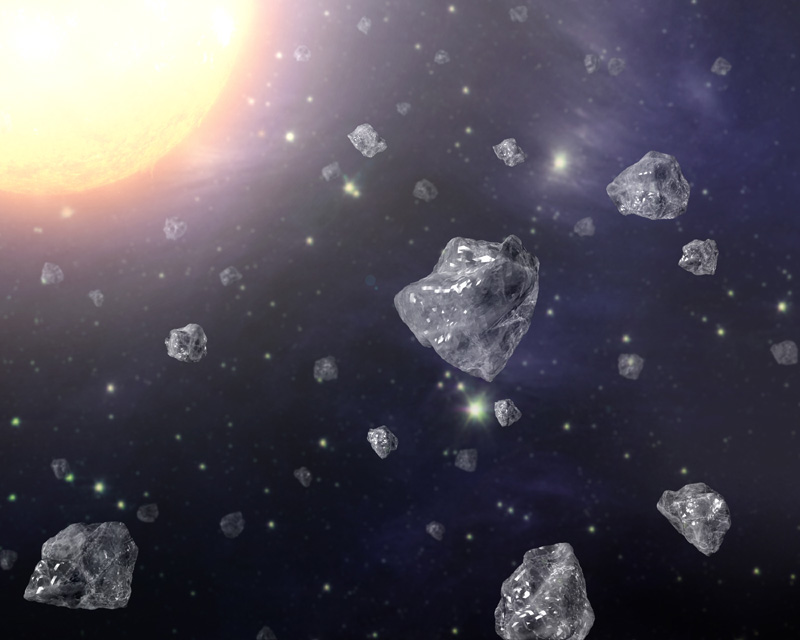Diamonds in the Sky

Stars are not the only objects that glitter in the dark night sky. Scientists have discovered that diamonds are plentiful in outer space. Some of these space diamonds are called “nanodiamonds” because they are incredibly small. A nanodiamond is millions of times smaller than a grain of sugar—more or less the size of a strand of DNA. Nanodiamonds are stardust, created when ancient stars exploded long ago, disgorging their remaining elements into space. Other space diamonds are huge—the size of whole planets—while some may exist in liquid or frozen form. Scientists even suggest that planets in our own solar system may have oceans filled with chunks of frozen diamond “ice.”
right:0in; text-indent:0.25in; ">
Diamonds are so common throughout the universe because they are a pure form of one of the universe’s most common elements: carbon. Diamonds have a number of amazing properties: they are extremely hard and transparent, and can withstand radioactivity, corrosive acids, and other powerful forces. Diamonds conduct electricity more readily than copper, and are also the best natural conductor of heat that we know of—which is why diamonds feel cool to the touch. Like a prism, diamonds produce rainbows from white light. The melting point of a diamond, 7,362 degrees Fahrenheit, is higher than that of any other known substance.
right:0in; text-indent:0.25in; ">
Graphite and diamonds share the same chemistry—both are carbon. The difference lies in the arrangement of the carbon atoms, known as their “molecular structure.” Extreme forces are required to transform dark, soft graphite—the stuff used in pencil lead—into hard, brilliant diamonds. A diamond is formed when carbon is exposed to immense pressure and extreme heat—conditions found hundreds of miles below the surface of the Earth, where most natural diamonds are formed. The heat and pressure squeeze the carbon atoms into a dense, crystalline structure. In the comic books, Superman could create a diamond by simply squeezing carbon in his bare hands, but it normally takes billions of years for carbon to become a diamond.
right:0in; text-indent:0.25in; ">
In space, diamonds are born more quickly. Scientists believe space diamonds often crystallize in no more than a millionth of a millionth of a second, when dust grains containing carbon smash together at extremely high speeds. Another hypothesis for how space diamonds are formed involves the shock waves released by an exploding star, which cook and compress carbon dust until it becomes a diamond.
right:0in; text-indent:0.25in; ">
In the 1980s, geologists discovered microscopic diamonds embedded in meteorites that had fallen out of the sky, some with the same chemistry as natural diamonds found on earth. Scientists believe these diamonds were created when meteorites collided with asteroids in our solar system. Other diamonds found inside meteorites, however, contain a mixture of xenon gas found only in outer space. These diamonds are useful to scientists because they provide clues about the composition of stars and the history of the universe.
right:0in; text-indent:0.25in; ">
A rare form of diamond found in Brazil and the Central African Republic—called a “carbonado diamond” because of its black color—also appears to have extraterrestrial origins. The hydrogen found in these diamonds indicates that they were probably formed in hydrogen-rich interstellar space. Scientists believe that these black diamonds were once the size of asteroids before they exploded upon impact with the Earth’s surface.
right:0in; text-indent:0.25in; ">
Astronomers studying Uranus and Neptune think that diamond icebergs may drift in sparkling diamond oceans on these carbon-rich planets. While this sounds incredible, scientists have discovered that, given the right conditions, it is possible to liquefy a diamond. To test this, nuclear scientists used lasers to recreate the extremely high heat and pressure of Uranus and Neptune. Using a normal diamond, they heated it to a temperature of 50,000 degrees and applied pressure equal to 11 million times the pressure on Earth. Under these conditions, the diamond first melted, then froze into icy chunks. In this way, scientists proved that diamonds can melt, freeze, and behave like water.
right:0in; text-indent:0.25in; ">
Scientists have even discovered a diamond planet in our galaxy, 4,000 light years from earth and about five times larger than our own planet. It is heavier than Jupiter, the largest planet in our solar system. Astronomers believe that this diamond planet formed when the carbon core of a massive star collapsed and became a diamond under intense gravitational pressure.
right:0in; text-indent:0.25in; ">
Besides being beautiful to contemplate, space diamonds teach us important lessons about natural processes going on in the universe, and suggest new ways that diamonds can be created here on Earth.
Note
Only spelling mistakes, if any, has been corrected. No other corrections, including grammatical, have been made so that the originality of the passage is maintained.
GRADE:9
Word Lists:
Meteorite : a meteor that survives its passage through the earth's atmosphere such that part of it strikes the ground. More than 90 percent of meteorites are of rock, while the remainder consist wholly or partly of iron and nickel.Extraterrestrial : of or from outside the earth or its atmosphere
Interstellar : occurring or situated between stars
Asteroid : a small rocky body orbiting the sun. Large numbers of these, ranging in size from nearly 600 miles (1,000 km) across (Ceres) to dust particles, are found (as the asteroid belt) especially between the orbits of Mars and Jupiter, though some have more eccentric orbits, and a few pass close to the earth or enter the atmosphere as meteors.
Scientist : a person who is studying or has expert knowledge of one or more of the natural or physical sciences
Corrosive : tending to cause corrosion
Planet : a celestial body moving in an elliptical orbit around a star.
Liquefy : make or become liquid
Laser : a device that generates an intense beam of coherent monochromatic light (or other electromagnetic radiation) by stimulated emission of photons from excited atoms or molecules. Lasers are used in drilling and cutting, alignment and guidance, and in surgery; the optical properties are exploited in holography, reading bar codes, and in recording and playing compact discs.
Solar : relating to or determined by the sun
More...

Questions and Answers
Popular Passages:
Ratings & Comments
Report an Error



